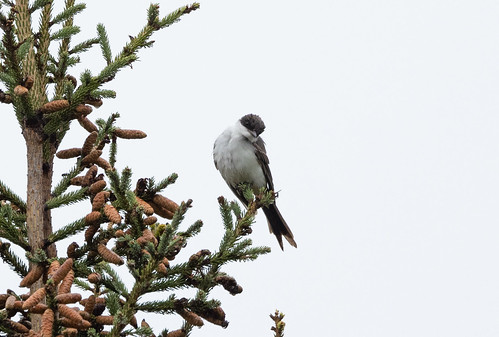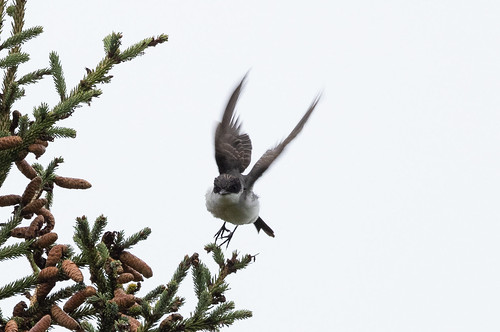I’m behind on several deadlines, so Saturday morning, after I drank my coffee while plotting out my calendar for the coming week and then started laundry and put my pills together for the week, I set to work on my computer. It was still dark and it was supposed to rain all day, so I was pretty sure I wouldn’t have to deal with many distractions.
This is the peak of Blue Jay migration, but the rain was keeping them down. Unfortunately, “down” turned out to be my backyard for a bazillion of them. I set out peanuts and a blend of seeds and nuts before I got to work, but at first light the jays pigged out on the tastier stuff and then, like Oliver Twist, a few approached me with their plaintive, “Please, sir. I want some more.”
Like Mr. Bumble, I’m pretty good at ignoring hungry little ones at the window feeder in my home office while I’m working on my computer at my desk treadmill. My window feeder is right next to my desk, and one jay has taken to rising up from the feeder in the Blue Jay version of a hover, staring at me as it flaps its wings at my eye level as long as it can before it drops to the feeder and tries again. That’s hard to ignore. And if that jay isn’t around, a couple of others have learned to catch my eye by sitting on the air conditioner jutting out of the window right in front of my desk at exactly the right angle that if I glance below my monitor, there they are, giving me a long, hard stare. I’m not quite as hard-hearted as Mr. Bumble, so I can’t help myself—I must oblige them. On Saturday, I was still working hard despite the interruptions. As long as the rain kept up, it was looking to be a productive day.
But then at 8:18, I got a text message from Alex Sundvall saying that Adam Sell had found a Fork-tailed Flycatcher at Stony Point, about 12 miles up the shore in Duluth Township, and my productive day went out the window. I grabbed my binoculars, camera, and raincoat, changed from my treadmill shoes to more water resistant ones, and set out.
Meanwhile, text messages were warning that Adam Sell couldn't relocate the bird. This happened to be the day of Duluth’s annual in-line skating race, which follows the same route as Grandma’s Marathon, closing off London Road and Scenic Highway 61. From my neighborhood it was easy to follow Superior Street straight onto the freeway, but the roads that cross between the two highways were closed. I’d have to cross Scenic 61 at Alseth Road to get to where the bird had been. Even though Alseth was marked closed, a bunch of cars were parked there with binocular-clad people getting out, so I pulled in. Hope may be the thing with feathers, but we’re talking about a bird who’d flown up here from South America, five or six thousand miles away. Where it was headed next, no one could know. Would I luck into seeing it?
The last time a Fork-tailed Flycatcher was seen in my neck of the woods was thirty years ago, in May 1992 up in Grand Marais. That one stuck around for several days so a lot of birders got to see it. I dragged my whole family up—that was the bird that inspired my 6-year-old Tommy to start a life list. The previous fall, one had turned up in Duluth, but Peder Svingen was the only one who saw it—Kim Eckert and I arrived minutes after Peder called but it was gone for good. Before this Saturday, not one other birder had seen a Fork-tailed Flycatcher for their St. Louis County list, and it would have been a lifer for lots of people. Plus it’s a darned cool bird. No wonder dozens of birders rushed to Stony Point within minutes of word getting out.
 |
Fork-tailed Flycatchers range from Mexico down through Argentina, but the Mexican subspecies is non-migratory. It’s the birds breeding in the southernmost part of their range in South America who migrate north for the austral winter, so oddly enough, the Fork-tailed Flycatchers who breed the furthest from the United States are the ones who make occasional appearances here. Vagrants are so rare that this was the last bird Roger Tory Peterson added to his North American life list.The birders gathering on Stony Point to see it comprised sort of a Who’s Who of northeastern Minnesota birders, and text messages were flying from Twin Cities birders already on the road in hopes of seeing it.
After Adam Sell got a good look and photos, the bird disappeared. Now as dozens of birders were arriving, no one could find it. Living up to their name, flycatchers sally from tree branches to catch flying insects, but rain was keeping both birds and insects down. Some of us wandered up and down the road a bit from where the bird had been seen, but while the rain was heavy, we were also clustering in groups catching up with each other’s news.
When the rain finally slowed down, Bruce Munson wandered by himself a tenth of a mile up to Stony Point Road to get a different vantage point, turning out of our sight range. Suddenly a few birders near me spotted what could have been the bird flying toward where Bruce was. Sure enough, a few moments later, he saw it light on a spruce tree and sent out a text message. Everyone charged over.
I barely got a glimpse before it flew off, and people behind me didn’t see it at all. But then suddenly it flew to the top of another spruce next to where a starling was perched. It was off a ways, but I got identifiable photos. A few people had brought spotting scopes, so I’m pretty sure everyone there got decent looks.
When it flew in the direction of where it had first been seen, we all scurried back. Now it was perched much closer to the road. Despite the foggy, gray conditions and back lighting, this time I got halfway decent photos.
Then it flew across Alseth toward the freeway, perched one more time giving us a last look, and disappeared for good. Some birders kept searching, knowing that in an hour or so, birders who’d booked it from the Twin Cities would start arriving, but no one managed to find it again.
Vagrant birds provide unexpected and lovely grace notes that make our lives so much richer and more interesting. Even when we miss a good one, like the King Eider in Grand Marais that I missed by barely 10 minutes back in the 80s, they give us cool stories and memories.
Thirty years between Fork-tailed Flycatcher sightings in northeastern Minnesota is a long time—many of the birders who saw this bird Saturday were babies or hadn’t been born yet when the Grand Marais bird appeared, and of my own age cohort, many had been too busy with work lives to drive so far for a bird likely to disappear before they got there. It must have been cosmically disappointing for Twin Cities birders who drove up in the rain only to miss it.
A Fork-tailed Flycatcher might not reappear in Minnesota for another three decades, but then again, it could be three weeks, or three days. Hope is not the only the thing with feathers. You never know when the next Fork-tailed Flycatcher’s feathered wings will carry it our way.






